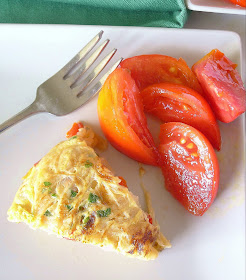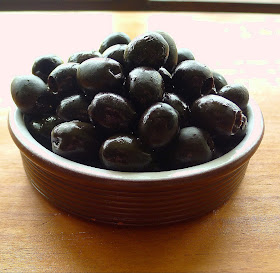I bought a pound of small shrimp to use as garnish for a dish I was going to photograph. In the end, I didn’t use them. So I cooked the whole, unpeeled shrimp (1 minute in boiling salted water) and put them out for a family meal for whoever was willing to peel them. My grandson Lucas and I devoured those little crustaceans. They were so sweet, so fresh.
These were the variety of shrimp known as gamba arrocera, a small, wild-caught shrimp especially esteemed on the Atlantic coast of Huelva (Andalusia), although they are also caught in the Mediterranean. They are the shrimp I remember eating in local tapa bars years ago. Always simply boiled, they were served plain and unadorned. You peeled them yourself and, in those days, dropped the shells on the floor!
 |
| Whole, raw shrimp. |
 |
| Same shrimp after cooking. |
 |
| Cooked, peeled and marinated in fresh lemon juice, the small shrimp go into a seafood cocktail called ceviche. |
 |
| A favorite in Spanish restaurants, avocado halves with shrimp and a dollop of salsa rosa, pink cocktail sauce. This one eschews the usual ketchup. |
They are also the shrimp added to paella and other rice dishes—thus their nomenclature “arrocera.” Cooked and peeled, they turn up in soups and in a favorite tapa bar salad, salpicón. The small shrimp—peeled raw—were used as well in tapa bars for gambas al ajillo, or, as it was called in Málaga region, gambas al pil pil. Nowadays it’s common to use the larger langostinos. (More about varieties of shrimp/prawns here.)
Size varies. Mine were 54 shrimp (unpeeled with heads on) to the pound. The variety is also known as gamba blanca (Parapenaeus longirostris) or “white” shrimp, although it’s really a pale pink-beige color. It turns a darker rosy hue after cooking.
These fresh shrimp are best cooked immediately, then stored refrigerated. If kept raw more than a couple days, they begin to show a deepening violet/black color inside the shell of the heads. They are not spoiled!
It’s not necessary to devein the shrimp before eating them. The “vein” is perfectly edible. In larger varieties of shrimp, it can be very unsightly, so is generally removed. But, with these small ones, it’s not an issue.
I enjoyed those shrimp so much that I've bought them again. Some to serve plain--no dipping sauce, no lemon. Just shrimp. The rest I've peeled--pretty easy after they're cooked--to use in a refreshing cocktail called ceviche and with avocado and a piquant sauce.
Gambas Cocidas
Cooked Shrimp
Cooked Shrimp
 |
| Cooked and ready to peel and eat. |
1 pound whole small shrimp
10 cups water
¼ cup salt
Bay leaf (optional)
Lemon slice (optional)
Ice water
10 cups water
¼ cup salt
Bay leaf (optional)
Lemon slice (optional)
Ice water
Rinse and drain the shrimp. Bring water to a boil with the salt in a deep pot. Add bay leaf and lemon slice, if using. Have a large bowl of ice and water ready.
Either serve the shrimp immediately or store them, covered and refrigerated for up to 24 hours.
 |
| To peel cooked shrimp: break off the head (suck out the delicious juices if you like). Pinch off the tail and the "legs." Unwrap the shell from the body. |
Shrimp Ceviche
Cebiche de Gambas
Cebiche de Gambas
 |
| Crunchy peppers and onions, buttery avocado, sweet shrimp and tart lemon. |
Unlike some ceviche recipes, this one calls for cooked, not raw, shrimp. The shrimp need only 10 minutes in the lemon marinade.
Serves 4 as a starter.
1 cup (5 ounces) cooked and peeled small shrimp
½ cup fresh lemon juice
¼ small red onion, cut in thin julienne
Salt
¼ cup diced yellow bell pepper
1 tablespoon minced fresh green chile, such as jalapeño
1 avocado, diced
¼ cup peeled and chopped tomato
1 tablespoon extra virgin olive oil
2 tablespoons chopped cilantro
½ cup fresh lemon juice
¼ small red onion, cut in thin julienne
Salt
¼ cup diced yellow bell pepper
1 tablespoon minced fresh green chile, such as jalapeño
1 avocado, diced
¼ cup peeled and chopped tomato
1 tablespoon extra virgin olive oil
2 tablespoons chopped cilantro
 |
| Shrimp in lemon juice. |
Place the shrimp in a small glass bowl. Pour over the lemon juice. Let the shrimp marinate, refrigerated, for 10 minutes.
Place the thinly sliced onion in a small bowl. Add ½ teaspoon salt and cover with water. Allow the onion to soak for 10 minutes.
In a bowl combine the diced yellow pepper, green chile, avocado and olive oil. Season with salt. Drain the soaked onions and add them to the bowl. Add the shrimp and lemon juice. Add the cilantro. Mix gently. Divide the ceviche between 4 cocktail cups.
Avocado with Shrimp
Aguacate con Gambas
Aguacate con Gambas
 |
| Serve the pink cocktail sauce on the side or--- |
 |
| --dollop it right on the shrimp and avocado. |
Avocados
Lemon juice
Cooked and peeled shrimp
Pink Cocktail Sauce
Cut avocados in half and remove pits. Sprinkle them with lemon juice. Fill the cavities with shrimp. Place a dollop of pink cocktail sauce on top of the shrimp.
Pink Cocktail Sauce
Salsa Rosa
Salsa Rosa
1 plum tomato, peeled and chopped
1 tablespoon chopped onion
½ tablespoon chopped green chile, such as jalapeño
1/8 teaspoon hot pimentón (paprika) or a pinch of cayenne
½ cup mayonnaise
1 tablespoon extra virgin olive oil
½ tablespoon lemon juice
Salt
½ tablespoon chopped green chile, such as jalapeño
1/8 teaspoon hot pimentón (paprika) or a pinch of cayenne
½ cup mayonnaise
1 tablespoon extra virgin olive oil
½ tablespoon lemon juice
Salt
Place the tomato, onion and chile in a mini processor and grind them finely. Add the pimentón, mayonnaise, olive oil, lemon juice and about ½ teaspoon salt. Process to make a smooth sauce.
Sauce keeps, covered and refrigerated, up to 2 days.
****
At the Feria de la Gamba (Shrimp Fair) in Cartaya (Huelva, Andalusia), 8-11 of August, two tons of shellfish will be served up. Other shrimp fairs in Punta Umbría and Isla Cristina take place at other times of the year.
****
More recipes with shrimp:
Chickpeas with Shrimp and Fish Sausage.Baked Shrimp with Sherry.
Zucchini Tubs with Shrimp Stuffing.
Piquillo Peppers Stuffed with Shrimp.
Flamenco Salad with Shrimp and Fruit.
Sizzling Garlic Shrimp with Chorizo.
Batter-Fried Shrimp.
Shrimp Boil a la Costa del Sol.
Classic Shrimp al Ajillo.
Shrimp and Fideo Noodle Salad.
Eggplant and Shrimp Rollups.
Shellfish Cocktail with Shrimp.
Rice with Shrimp and Mango.
Shrimp Cocktail with Avocado (Salpicón).
Pasta with Garlic Shrimp and Zucchini.




























